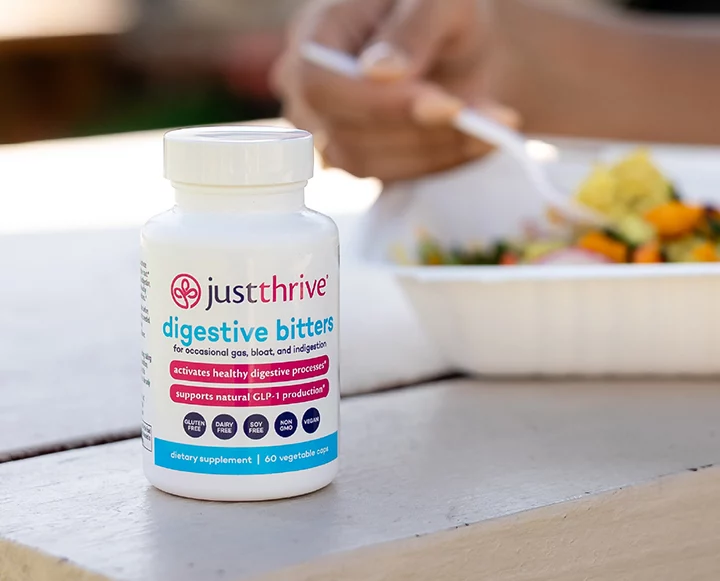Bread has a bit of a bad rap of late. With the surge in gluten sensitivity, many wellness-minded folks have sworn off bread altogether, but if you love a little toast here and there, sourdough, which is naturally fermented, is one of the healthiest options. Featuring a fermented starter that you can make at home, sourdough bread is gentler on the gut in a way other bread isn’t.
Traditional sourdough breads are often fermented for periods longer than 24 hours. This timeframe allows for the yeasts to thoroughly digest the natural sugars in the flours. For this reason, traditional sourdough breads may be more easily digested by those who have trouble consuming other bread products.
We’re learning all about how to make sourdough bread at home from the inspiring ladies behind Heritage Gatherings, who combine stunning natural locations with education on traditional techniques like this one. Discover their sourdough process below, and join them for their new series of classes centered around traditional cooking methods, gardening, herbalism, animal care, making and crafting here.
What Is Sourdough? Sourdough is an old gift from science traced back from ancient Egypt, and is the first form of leavened bread. Sourdough is made by the fermentation of dough using naturally-occurring lactobacilli and yeast. It has a mildly sour taste, and better inherent keeping qualities due to the lactic acid produced by the lactobacilli. The souring of the dough is healthier for us than non-fermented breads. The fermentation process makes it easier to digest by breaking down gluten and providing the good tummy bacteria, a natural probiotic if you will. I love baking with sourdough because of the health benefits and flavor profile.
Why Is Sourdough Better? My love for DIY sourdough started when I became a mother. I had always had an eye on health and cared about what I put into my body. Yes. I am that person who reads food labels meticulously. But when I had a child of my own I really started to pay attention to what ingredients went into my body and our family’s bodies. I remember going to buy a loaf of bread at the store, turning over the package and seeing a paragraph long ingredient list of ingredients and gasping. Bread is simple, it shouldn’t need more than just flour, water and salt, maybe some levain or yeast… right? That’s when I journeyed into the art of sourdough bread baking at home. I taught myself how to make a starter using just flour and water then started making a simple no-knead bread — recipe below!
How To Pick The Right Flour
On Sourdough Starter. A sourdough starter is a simple mixture of flour and filtered water that naturally ferments. Some sourdough starters are family heirlooms passed down generations, while others are just for a short time. If it goes bad, it’s okay, it’s easy to make again.
On Picking Your Flour. When I first started making sourdough I really didn’t think about the flour I was using. I think I simply used all-purpose flour. But I quickly learned that not all flour is created equal and that they type of flour used can make a big difference. For this reason I recommend using a good quality flour when starting out. Search for flour that is unbleached and one that does not contain a lot of added chemicals.
If you are new to baking, I recommend using bread flour. Bread flour has a higher protein and gluten content which means it’s easier to work with and can produce a better rise. All purpose flour can be used but because it is lower in protein it can create a wetter dough that is more difficult to work with. Whole grain flours are great flours too. They can just be trickier as they are higher in minerals which can speed up the fermentation time and can create a wetter dough. Lastly, to get more consistent results when baking I find that it’s important to use that water that is filtered and unchlorinated.
Other Helpful Tools for DIY Sourdough Bread
The following tools are helpful when baking bread:
Dough whisk. This can be used to help incorporate the flour and water together. CHECK OUT
Dough scraper. This can be used to better handle the dough when shaping. CHECK OUT
Mixing bowls. Make sure your bowl is large enough to mix all of your ingredients. CHECK OUT
Scale. This is one of the most important pieces in getting a more consistent loaf. Measuring ingredients allows for more precision. CHECK OUT
Dutch oven. Although you can bake your bread without a dutch oven, I find that a dutch oven works wonders on my bread and I often get a better rise if I use it too. CHECK OUT
Patience, love + kindness. The art of bread baking or really any ferment is to learn to be patient and kind on oneself even if it doesn’t turn out exactly as you planned. Remember the starter is wild so this adds another layer of trickiness but it can also be that much more rewarding.
How To Create Your Own Sourdough Starter
A sourdough starter is a simple mixture of flour and filtered, un-chlorinated water that naturally ferments. Some sourdough starters are family heirlooms passed down through generations, while others are just for a short time. If it goes bad, it’s okay, it’s easy to make again.
Ingredients:
flour
filtered water
Directions:
Creating a sourdough starter: Whisk ¼ cup flour with sourdough starter (if using), and 3 tablespoons filtered water in a small bowl. Pour this into a 1 quart canning jar, put canning lid on, let it sit for twelve hours. Twelve hours later, whisk in ½ cup flour with ½ cup filtered water and cover again. Continue adding ½ cup flour and ½ cup water every twelve hours for one week until the starter is pillowy and bubbling.
As you feed the starter, make sure to whisk in the flour and water thoroughly into the established starter. Aerating the starter will help to yield the best and most reliable results.
Make sure your jar is only half full after each feeding to accommodate the sourdough’s expansion. If you’ve made too much sourdough starter for the capacity of the jar, pour some off and use it in sourdough biscuits, sourdough waffles, flatbread, crepes, etc.
Maintaining the sourdough: After a week, the sourdough should be sturdy enough to withstand storage. If you bake infrequently (that is, baking less than once a week), you can store the sourdough in the refrigerator, bring it to room temperature, and discard all of the starter except 1 Tbsp. Then feed starter 1 cup flour and 1 cup of water six to eight hours before you plan to bake. If you bake more frequently (every day or a few times a week) you can store the sourdough at room temperature, and feed it with ¼ cup flour and ¼ cup filtered water once a day. Discard starter when needed to accommodate for expansion.
Note: If a brown liquid appears floating on top of the sourdough starter, simply pour it off. This often means you’ve fed the starter too much water in relation to flour or let the starter go too long without feeding it.
How To Make DIY Sourdough Bread
Ingredients:
3 ½ to 4 cups (500g) bread flour
1/4 cup (100g) starter (I feed my starter 6 to 8 hours before I want to bake bread)
1 1/2 cups (350g) filtered water
1 teaspoon fine grained sea salt
Directions:
Six to eight hours before you are going to start your bread making process, discard all of your starter except 2 tablespoons of starter. Add 1 cup of flour and 1 cup of water. Whisk vigorously, cover, and let sit. This will give the starter a 100% hydration rate. If after 6-8 hours the starter is not extra bubbly, check in another 2 to 3 hours. If still having trouble getting starter to be vigorous and bubbly, then start the process all over again.
In a large bowl, combine water and the 100% hydrated starter. Next, combine flour and salt until mixed together, and a ball can form.
Cover with bees wrap, or cling wrap, and let sit for at least 6 to 8 hours in bowl.
Form your loaf. Lightly dust flour or arrowroot powder on your kitchen counter. Scoop dough out onto the floured surface then sprinkle lightly with more flour. Gently create a rectangle. Fold into thirds, and then in thirds again to create a ball.
Place more flour or arrowroot powder on a clean tea towel. Invert the loaf with the rough edge side up, and place back in bowl. Cover and let sit for 60 min, up to 3 hours, on your counter, or up 12 hours in the fridge.
When ready to bake, place a large ovenproof dish with a lid in the oven, (I use a dutch oven). Preheat oven to 500°F and the ovenproof dish for at least 1/2 hour.
Carefully remove the hot pan from the oven. Remove lid. Gently place the loaf in the pan inverted so the rougher surface is now on the bottom. Score the loaf if you desire.
Pop the lid back on, turn the oven down to 450°F and bake for 20 minutes.
Remove the lid, and bake for another 20 minutes until the loaf is deep golden brown.
Cool on a wire rack uncovered for at least 1 hour if you can wait that long. Enjoy!
Note: I prefer to use a combination of unbleached, stone ground organic soft red wheat flour, whole grain hard red wheat flour, and filtered water. And you can also use supermarket flour with great results.












